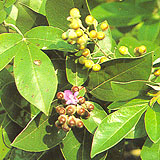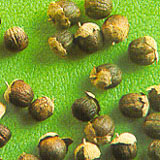Chastetree Fruit
http://www.100md.com
《e Natural Health Center》
 |
 |
 |
Herbs for Dispelling Wind and Heat
Chastetree Fruit
Latin:
Semen Vitex trifolia L
Origin:
As the ripe fruit of Vitex trifolia L. var. simplicifolia Cham or Vitex trifolia L., a deciduous undershrub, of Verbenaceae, this herb is mainly produced in Shandong, Jiangxi, Zhejiang, Fujian, etc., most of which are wild, picked and reaped in summer, dried in the shade and used when raw or after being fried.
, 百拇医药
Properties:
Pungent and bitter in flavor, slightly cold in nature, it is related to the urinary bladder, liver and stomach channels.
Functions:
Dispels pathogenic wind-heat and refreshes the head and eyes.
Applications:
1. Used for common colds due to pathogenic wind-heat, headache and head wind syndrome:
, 百拇医药
Being so pungent as to dispel wind, slightly cold with the ability to clear heat and so light as to rise up, this herb disperses pathogens from the head and face and expels wind to relieve pains, so it is used together with chrysanthemum, peppermint, etc., for the treatment of affection by exopathogenic wind-heat, headache and dizziness; often used together with white puncture vine fruit (Fructus Tribuli), chuanxiong (Rhizoma Ligustici Chuanxiong), hooked uncaria stem (Ramulus Uncariae cum Uncis), etc., for headache and head wind syndrome.
, 百拇医药
2. Used for conjunctivitis (inflammation of the conjunctiva, or the eyelids) and blurring of vision:
This herb can dispel wind, clear heat and refresh the head and eyes, so it is often used in combination with chrysanthemum, cicada slough, rough gentian root (Radix Gentianae), etc., for the treatment of conjunctivitis and blurring of vision due to upward attacks of pathogenic wind-heat. Being rising and dispelling in property, this herb refreshes the head and eyes, and can also be used together with milk vetch root (Radix Astragali seu Hedysari), dangshen (Radix Codonopsis Pilosulae), herbaceous peony root (Radix Paeoniao Alba), etc., e.g., Yiqi Congming Tang, for the treatment of nebula, tinnitus and deafness due to lucid yang failing to rise. In addition, this herb can also be used largely in combination with notopterygium root or rhizome (Radix seu Rhizoma Notopterygii), angelica root (Radix Angelicae Pubescentis), chuanxiong (Rhizoma Ligustici Chuanxiong), fangfeng (Radix Ledebouriellae), etc., e.g., Qianghuo Shengshi Tang, for rheumatism and arthralgia by making use of its effects of dispelling wind and killing pains.
, 百拇医药
Dosage and Administration:
6-12 g.
Decoct the ingredients for drinking.
Cautions on Use:
Reference Materials:
'Shen Nong's Herbal Classic' :
"It is indicated for wind-heat syndromes between bones and muscles and it improves eyesight and reinforces the teeth."
, 百拇医药
'Other Medical Records of Famous Physicians' :
"It treats severe and migratory arthralgia, Tinnitus cranii and hyperdacryosis."
Toxic or Side Effects:
Modern Researches:
This herb contains a volatile oil with such main ingredients as camphene, micro-alkaloids, Vitamin A and casticin. Chastetree fruit has certain tranquilizing, analgesic and antipyretic effects. The distilled extract of chastetree leaves can promote the microcirculation of the periphery and internal organs., 百拇医药